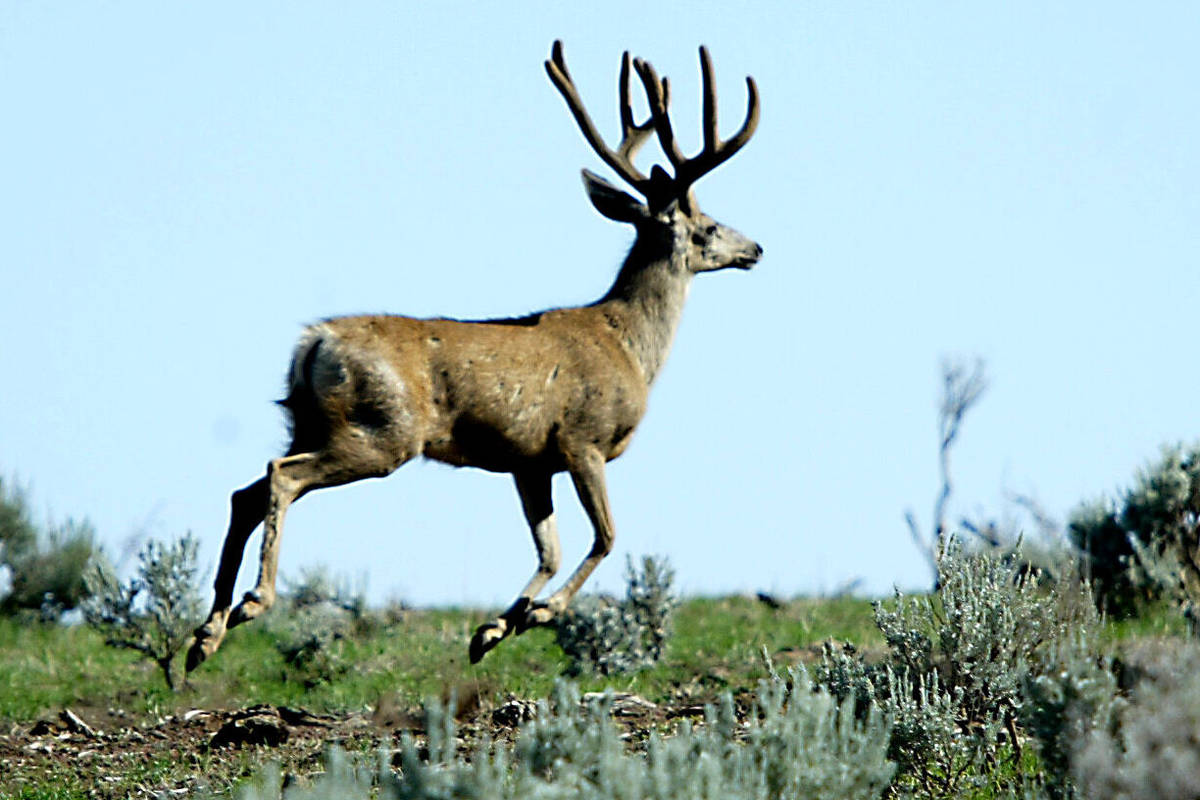Antler growth good indicator of mule deer buck’s health

One by one, a handful of mule deer bucks make their way up the steep slope on the far side of the pocket that lay between them and us. Through our binoculars we watch as they travel in single file, alert and moving quickly through the sagebrush but not yet bounding in the long, ground-eating jumps the species is known for.
Then, as mulies are prone to do, they each stop in turn and look back over their shoulders before moving on. Each is a handsome specimen with tall, dark antlers typical of Nevada mulies. It is opening day of muzzleloader season, but we are content to watch the parade.
Suddenly another buck bolts from his hiding place and races to join the others. He is a dandy four-point, but it is the color of his antlers rather than their size that stands out. They are bone white with streaks of red, blood red.
Though the scene is startling at first, we soon realize that the buck is not injured but instead is shedding the velvet covering that had protected his antlers since they began growing in early spring. A natural process neither of us had ever witnessed firsthand.
Though people sometimes refer to antlers as horns, they are not really horns. Bighorn sheep, bison, mountain goats and cattle have horns, but members of the deer family have antlers.
Horns are permanent bone growths covered with a keratin sheath. Antlers are bones that grow out of the skull and then are shed each year. You will see them on animals such as mule deer, whitetail deer, elk, caribou and moose.
According to the Western Association of Fish and Wildlife Agencies’ Mule Deer Working Group, “Antlers are actually bones that exist outside of the body and are supplied with nutrients via blood flow while growing. They eventually die, drop off and immediately begin growing again.”
Antler growth takes place from visible spots of specialized tissue on the animal’s forehead called a pedicle and is the fastest bone growth in the world. On one of its web pages, the U.S. Fish Wildlife Service says, whitetail deer antlers can grow ¼-inch per day, elk antlers grow about an inch per day, and a moose can grow as much as a pound of antler per day. That is impressive.
Just how large an animal’s antlers grow depends on age, nutrition and genetics. It makes sense that as a buck gets older his antlers get bigger. Studies of whitetail deer have that fact well documented. Eventually, however, an animal reaches a point in its life where its antler growth and overall health begin to decline.
In mule deer you might notice this decline when you see a large-framed mulie buck with crab claw forks where deep forks and long tines should be.
Nutrition is key to antler growth, especially during the summer months. When habitat conditions are prime and there is plenty of feed to go around, you can expect to see good antler growth. But when habitat conditions are on the decline, you can expect to see just the opposite.
When summer range is limited, or winter range too for that matter, mule deer populations suffer.
“Nutrition affects every aspect of mule deer population biology and ecology. Nutrition influences mule deer body condition, which in turn influences reproduction, recruitment, antler growth, home range size, seasonal movements, longevity, predator avoidance, and the ability to negotiate changing habitats. No other single factor has such an overriding effect on this species,” wrote the Mule Deer Working Group.
Freelance writer Doug Nielsen is a conservation educator for the Nevada Department of Wildlife. His “In the Outdoors” column is not affiliated with or endorsed by the NDOW. Any opinions he states in his column are his own. Find him on Facebook at @dougwritesoutdoors. He can be reached at intheoutdoorslv@gmail.com